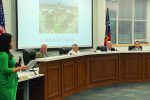‘Poor decision making’ at heart of balloon crash
By LPR Staff
Editor/POST-REGISTER
*UPDATED FROM PRINT*
“A pattern of poor decision-making” was the cause of the catastrophic balloon accident that killed 15 passengers and a pilot in the skies above Maxwell in July 2016, the National Transportation Safety Board (NTSB) concluded on Tuesday.
In the final hearing after an investigation that spanned over well over a year, the four-member panel voted unanimously on Tuesday to enter a probable cause finding that balloon pilot Alfred G. “Skip” Nichols’ decision to launch that morning, to continue the flight, despite increasing clouds and fog, and to attempt to descend through a patch of clouds were the cause of the deaths of 15 innocent people.
Contributing factors to the accident, they concluded, were Nichols’ myriad medical conditions and medications, some of which may have dulled his decision-making capabilities, and, were he a fixed-wing pilot, disqualified him from flight altogether. Additionally, they said, the failure of the Federal Aviation Administration to oversee medical fitness of commercial balloon pilots contributed to the accident.
“The pilot should not have been flying, never mind carrying paying passengers,” said NTSB Chair Robert Sumwalt. “The pilot’s decisions on that day were his, and his alone. They also affected those who flew with him. Other decisions, made within the government, going back decades, exempted him from having to hold an FAA Medical Certificate. Today’s recommendations, if acted upon, will bring safety standards and oversight of commercial passenger-carrying balloon operations closer to those that apply to [other] pilots. Pilots, their passengers, and their passengers’ loved ones deserve no less.”
Before the accident even occurred, NTSB had pushed the FAA to enact stricter regulations regarding medical certification of commercial balloon pilots. The FAA pushed back, noting the industry was so small and un-documented that it would be cost prohibitive, not only for the Agency, but for ballooning pilots, to engage in the same Class Two Medical requirements that fixed-wing and helicopter pilots have to adhere to.
What’s more, the FAA was notified in 2013 that Nichols had a history of drug- and alcohol-related criminal offenses, including several DUI charges. At the time the FAA chose not to pursue action against his pilot’s license. Had the issue been pursued when it was brought forward, it’s likely that Nichols would have had his license suspended, if not revoked altogether.
As previously reported, at the time of his death, Nichols had more than 13 prescription and non-prescription drugs in his system, including Valium, Benadryl and Oxycodone, each of which could have dulled his decision-making and response times.
“Each of the medications that we talked about that were identified on toxicology, in combination or alone could degrade somebody’s performance and ability to make clear decisions,” said Dr. Nicholas Webster. “We’ll take a look at just one – we’ll look at Benadryl. At the level he was at, it had the impairing effect of a blood-alcohol of 0.1, which is above the legal limit to operate a car in all 50 states.”
Webster went on to say that the combination of medications, along with Nichols’ medical diagnoses, made it unsafe for him to fly that morning.
A contributing factor to the crash, experts testified, was the weather.
Though the morning was clear up to the time of launch, photos gathered from the passengers’ electronic devices, meteorological data and witness testimony reflects that clouds and fog gathered during the flight, and that Nichols was aware it might happen.
“We look for a hole, and we go,” he is reported to have said the morning of the flight when calling for a weather report. All other ballooning operations in Central Texas cancelled their flights that day.
In a photo snapped just two minutes before the crash, clouds and fog can be seen thickening below the balloon. In that photo, one of the high-test LCRA power line towers can be seen through a patch in the fog.
The NTSB voted unanimously to provide yet another recommendation to FAA that commercial ballooning pilots be subject to Second Class Medical Exams, as other commercial pilots are, but it is unclear whether FAA will take action this time.
In Congress an in the Senate, Texas representatives have presented bills that would require FAA to make those changes. Both have been stalled in legislation that won’t be picked up until next year.
“I have long pressed the FAA to strengthen balloon safety to avert another disaster,” Congressman Lloyd Doggett said in a written statement on Tuesday. “While I have a pending amendment to long-delayed FAA legislation to require medical certificates for commercial balloon operators, nothing prevents the FAA from acting now. I agree fully with the NTSB Chairman that the FAA has been ‘shirking its responsibility.’ FAA’s rejection of NTSB recommendations would condemn more unsuspecting families to death.”
Pat Morgan, who lost her daughter, Lorilee and granddaughter, Paige, in the crash has been an outspoken advocate for changes to the FAA policies, even pushing a petition earlier this year encouraging President Donald Trump to get involved and call the FAA to action.
“FAA needs to be held accountable and respect the many lives that have been impacted by this tragedy,” she said. “Family and friends, we have much work to do and need your support. More people means more power.”Harvey Douglas, whose son, Scott, and daughter-in-law, Laura, were killed, echoed her sentiments, but said the industry needs even more. “NTSB along with others have expressed going forward, how we need new laws covering the hot air balloon industry, and I totally support these changes,” he said. “However there is one change that I don’t hear much about – the owners, or the pilots, are not adequately insured to operate a commercial/pleasure hot air balloon company. Mr. Nichols is the perfect example of being under-insured.”
The Post-Register will continue to follow the bills through legislation, and the FAA’s reaction to the NTSB findings.



